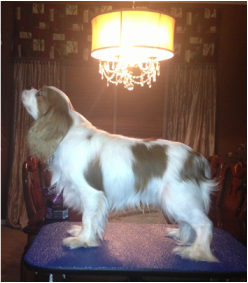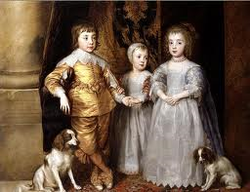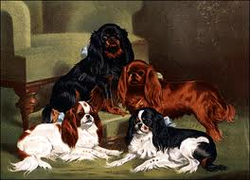
Some General Information about our AMAZING Dogs:
The Cavalier King Charles Spaniel is a delightfully affectionate, playful, intelligent little dog that repays his owner’s care and attention with an endearing devotion.
Cavaliers are not kennel dogs. Because of four hundred years of close contact with their owners and their development as lap dogs, they make wonderful companions. They are happy, outgoing, loving little dogs who want to love you and be loved, to run and play in a safe place, and to sleep in a soft bed - preferably your bed, but they’re willing to negotiate on that point! They get along well with children, cats, and other dogs.
Because young Cavalier puppies are so small, some breeders are reluctant to sell a puppy to a family with children under age five. Such families may find that an older puppy or grown dog may be more suitable. Cavalier puppies do not thrive when left all day without human companionship or the company of another animal. They are highly intelligent and require the same consistent and loving discipline as does a child.
Cavaliers are active and sporting little dogs that require regular exercise. They have an instinct to give chase to just about anything that moves, and should either be on a leash or in a fenced yard or they will surely come to grief under the wheels of a car. Because Cavaliers never become “street-wise,” some Cavalier breeders require a fenced yard as a prerequisite for Cavalier ownership.
While Cavaliers are clean, intelligent, and easy to groom and train, they do shed, occasionally chew things, and sometimes forget their manners by barking, making a puddle, and so on. In other words, they really are first and always dogs, in spite of their ethereal faces!
The Cavalier King Charles Spaniel is a delightfully affectionate, playful, intelligent little dog that repays his owner’s care and attention with an endearing devotion.
Cavaliers are not kennel dogs. Because of four hundred years of close contact with their owners and their development as lap dogs, they make wonderful companions. They are happy, outgoing, loving little dogs who want to love you and be loved, to run and play in a safe place, and to sleep in a soft bed - preferably your bed, but they’re willing to negotiate on that point! They get along well with children, cats, and other dogs.
Because young Cavalier puppies are so small, some breeders are reluctant to sell a puppy to a family with children under age five. Such families may find that an older puppy or grown dog may be more suitable. Cavalier puppies do not thrive when left all day without human companionship or the company of another animal. They are highly intelligent and require the same consistent and loving discipline as does a child.
Cavaliers are active and sporting little dogs that require regular exercise. They have an instinct to give chase to just about anything that moves, and should either be on a leash or in a fenced yard or they will surely come to grief under the wheels of a car. Because Cavaliers never become “street-wise,” some Cavalier breeders require a fenced yard as a prerequisite for Cavalier ownership.
While Cavaliers are clean, intelligent, and easy to groom and train, they do shed, occasionally chew things, and sometimes forget their manners by barking, making a puddle, and so on. In other words, they really are first and always dogs, in spite of their ethereal faces!

The Cavalier King Charles Spaniel History:
The Cavalier King Charles Spaniel of today is descended from the small Toy Spaniels seen in so many of the sixteenth, seventeenth, and eighteenth century paintings by Titian, Van Dyck, Lely, Stubbs, Gainsborough, Reynolds, and Romney. These paintings show small spaniels with flat heads, high set ears, almond eyes, and rather pointed noses. During Tudor times, Toy Spaniels were quite common as ladies' pets, but it was under the Stuarts that they were given the royal title of King Charles Spaniels.
History tells us that King Charles II was seldom seen without two or three spaniels at his heels. So fond was King Charles II of his little dogs, he wrote a decree that the King Charles Spaniel should be accepted in any public place, even in the Houses of Parliament where animals were not usually allowed. This decree is still in existence today in England. As time went by, and with the coming of the Dutch Court, Toy Spaniels went out of fashion and were replaced in popularity by the Pug. One exception was the strain of red and white Toy Spaniels that was bred at Blenheim Palace by various Dukes of Marlborough.
In the early days, there were no dog shows and no recognized breed standard, so both type and size varied. With little transport available, one can readily believe that breeding was carried out in a most haphazard way. By the mid-nineteenth century, England took up dog breeding and dog showing seriously. Many breeds were developed and others altered. This brought a new fashion to the Toy Spaniel - dogs with the completely flat face, undershot jaw, domed skull with long, low set ears and large, round frontal eyes of the modern King Charles Spaniel (also called "Charlies" and known in the United States today as the English Toy Spaniel). As a result of this new fashion, the King Charles Spaniel of the type seen in the early paintings became almost extinct.
The Cavalier King Charles Spaniel of today is descended from the small Toy Spaniels seen in so many of the sixteenth, seventeenth, and eighteenth century paintings by Titian, Van Dyck, Lely, Stubbs, Gainsborough, Reynolds, and Romney. These paintings show small spaniels with flat heads, high set ears, almond eyes, and rather pointed noses. During Tudor times, Toy Spaniels were quite common as ladies' pets, but it was under the Stuarts that they were given the royal title of King Charles Spaniels.
History tells us that King Charles II was seldom seen without two or three spaniels at his heels. So fond was King Charles II of his little dogs, he wrote a decree that the King Charles Spaniel should be accepted in any public place, even in the Houses of Parliament where animals were not usually allowed. This decree is still in existence today in England. As time went by, and with the coming of the Dutch Court, Toy Spaniels went out of fashion and were replaced in popularity by the Pug. One exception was the strain of red and white Toy Spaniels that was bred at Blenheim Palace by various Dukes of Marlborough.
In the early days, there were no dog shows and no recognized breed standard, so both type and size varied. With little transport available, one can readily believe that breeding was carried out in a most haphazard way. By the mid-nineteenth century, England took up dog breeding and dog showing seriously. Many breeds were developed and others altered. This brought a new fashion to the Toy Spaniel - dogs with the completely flat face, undershot jaw, domed skull with long, low set ears and large, round frontal eyes of the modern King Charles Spaniel (also called "Charlies" and known in the United States today as the English Toy Spaniel). As a result of this new fashion, the King Charles Spaniel of the type seen in the early paintings became almost extinct.

It was at this stage that an American, Roswell Eldridge, began to search in England for foundation stock for Toy Spaniels that resembled those in the old paintings, including Sir Edwin Landseer’s "The Cavalier's Pets." All he could find were the short-faced Charlies. Eldridge persisted, persuading the Kennel Club in 1926 to allow him to offer prizes for five years at Crufts Dog Show - twenty-five pounds sterling for the best dog and twenty-five pounds sterling for the best bitch -- for the dogs of the Blenheim variety as seen in King Charles II's reign. The following is a quotation taken from Crufts’catalog: "As shown in the pictures of King Charles II's time, long face no stop, flat skull, not inclined to be domed and with the spot in the center of the skull" and the prizes to go to the nearest to the type described.
No one among the King Charles breeders took this challenge very seriously as they had worked hard for years to do away with the long nose. Gradually, as the big prizes came to an end, only people really interested in reviving the dogs as they once had been were left to carry on the breeding experiment. At the end of five years little had been achieved, and the Kennel Club was of the opinion that the dogs were not in sufficient numbers, nor of a single type, to merit a breed registration separate from the Charlies.
In 1928 a dog owned by Miss Mostyn Walker, Ann's Son, was awarded the prize. (Unfortunately Roswell Eldridge died in 1928 at age 70, only a month before Crufts, so he never saw the results of his challenge prizes.) It was in the same year that a breed club was founded, and the name Cavalier King Charles Spaniel was chosen. It was very important that the association with the name King Charles Spaniel be kept as most breeders bred back to the original type by way of the long-faced throwouts from the kennels of the short-faced variety breeders. Some of the stock threw back to the long-faced variety very quickly. Pioneers were often accused of using outcrosses to other suitable breeds to get the long faces, but this was not true, and crossing to other breeds was not recommended by the club.
At the first meeting of the club, held the second day of Crufts in 1928, the standard of the breed was drawn up; it was practically the same as it is today. Ann's Son was placed on the table as the live example, and club members brought all the reproductions of pictures of the sixteenth, seventeenth, and eighteenth centuries they could muster. As this was a new and tremendous opportunity to achieve a really worthwhile breed, it was agreed that as far as possible, the Cavalier should be guarded from fashion, and there was to be no trimming. A perfectly natural dog was desired and was not to be spoiled to suit individual tastes, or as the saying goes, "carved into shape." Kennel Club recognition was still withheld, and progress was slow, but gradually people became aware that the movement toward the "old type" King Charles Spaniel had come to stay. In 1945 the Kennel Club granted separate registration and awarded Challenge Certificates to allow the Cavalier King Charles Spaniel to gain their championships.
INFORMATION SOURCE: www.CKCSC.org
No one among the King Charles breeders took this challenge very seriously as they had worked hard for years to do away with the long nose. Gradually, as the big prizes came to an end, only people really interested in reviving the dogs as they once had been were left to carry on the breeding experiment. At the end of five years little had been achieved, and the Kennel Club was of the opinion that the dogs were not in sufficient numbers, nor of a single type, to merit a breed registration separate from the Charlies.
In 1928 a dog owned by Miss Mostyn Walker, Ann's Son, was awarded the prize. (Unfortunately Roswell Eldridge died in 1928 at age 70, only a month before Crufts, so he never saw the results of his challenge prizes.) It was in the same year that a breed club was founded, and the name Cavalier King Charles Spaniel was chosen. It was very important that the association with the name King Charles Spaniel be kept as most breeders bred back to the original type by way of the long-faced throwouts from the kennels of the short-faced variety breeders. Some of the stock threw back to the long-faced variety very quickly. Pioneers were often accused of using outcrosses to other suitable breeds to get the long faces, but this was not true, and crossing to other breeds was not recommended by the club.
At the first meeting of the club, held the second day of Crufts in 1928, the standard of the breed was drawn up; it was practically the same as it is today. Ann's Son was placed on the table as the live example, and club members brought all the reproductions of pictures of the sixteenth, seventeenth, and eighteenth centuries they could muster. As this was a new and tremendous opportunity to achieve a really worthwhile breed, it was agreed that as far as possible, the Cavalier should be guarded from fashion, and there was to be no trimming. A perfectly natural dog was desired and was not to be spoiled to suit individual tastes, or as the saying goes, "carved into shape." Kennel Club recognition was still withheld, and progress was slow, but gradually people became aware that the movement toward the "old type" King Charles Spaniel had come to stay. In 1945 the Kennel Club granted separate registration and awarded Challenge Certificates to allow the Cavalier King Charles Spaniel to gain their championships.
INFORMATION SOURCE: www.CKCSC.org
